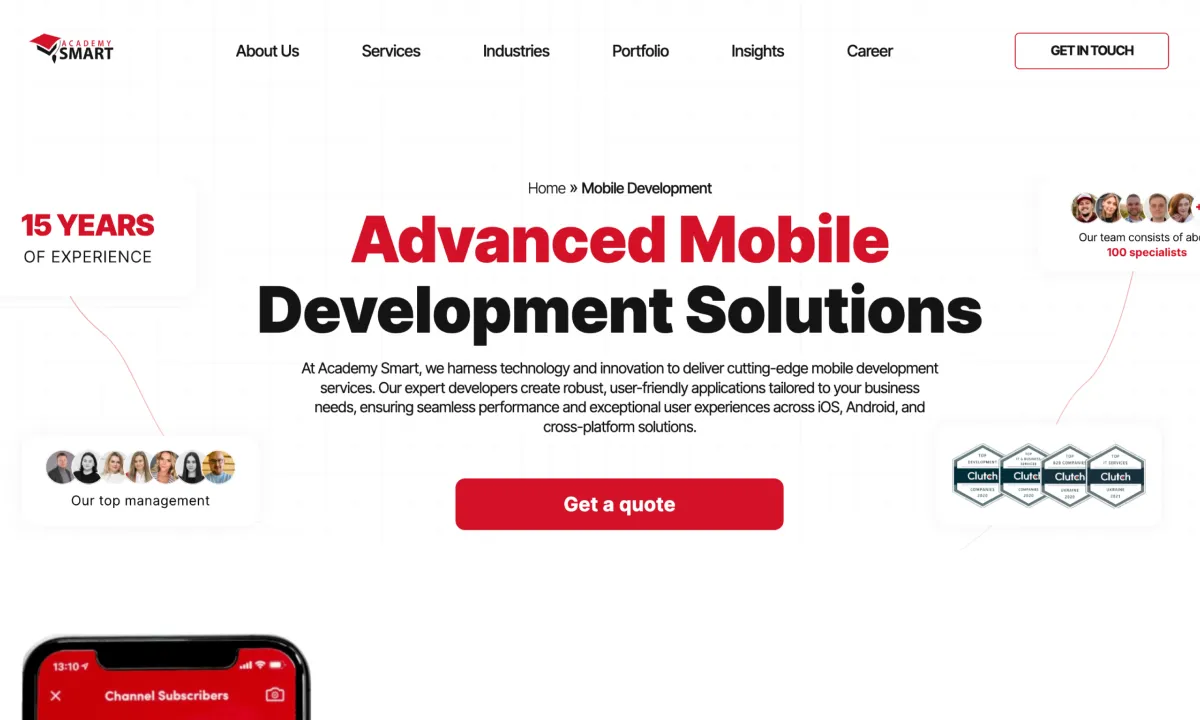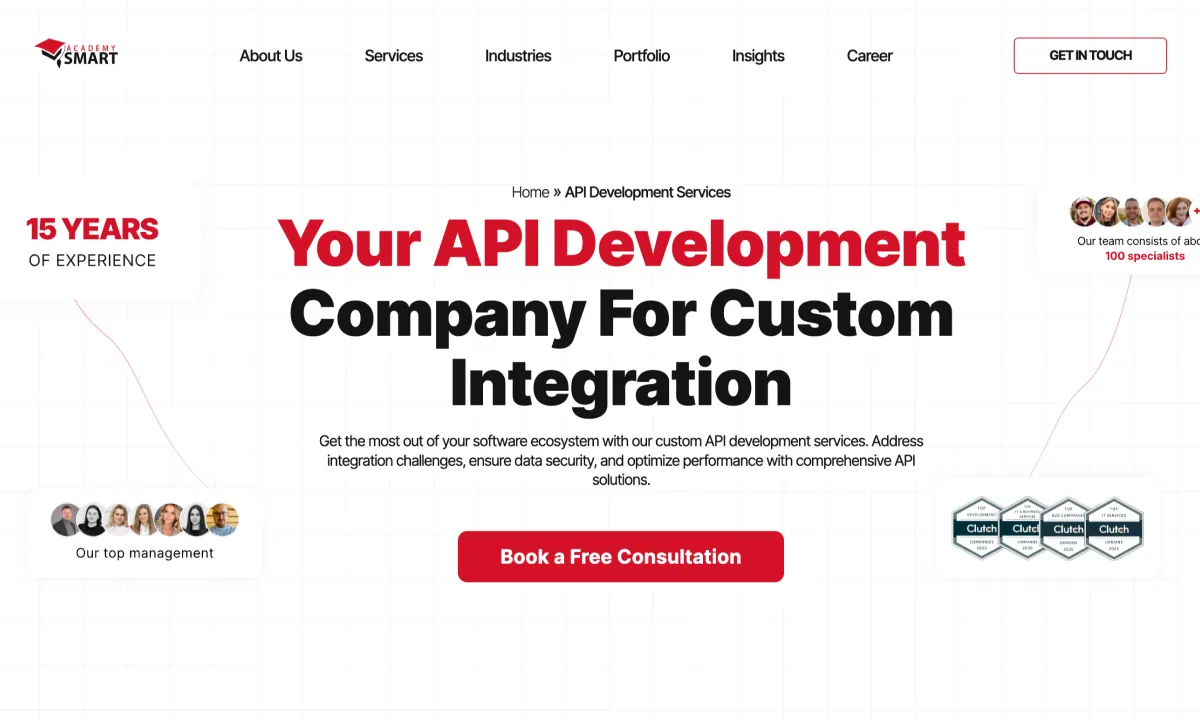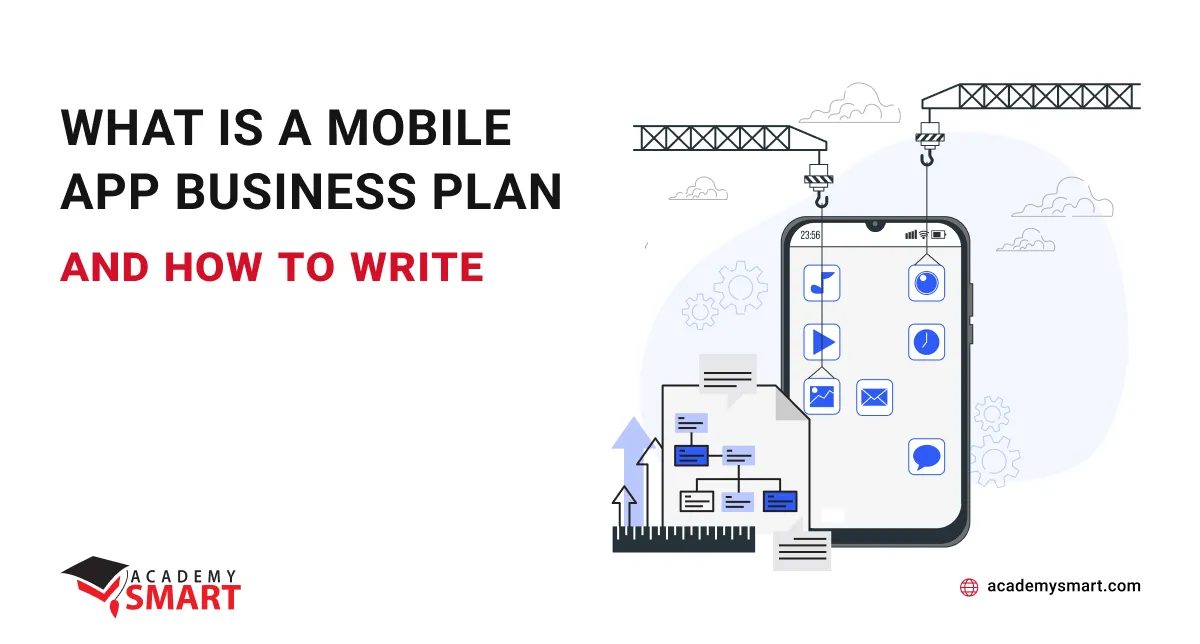
What is a Mobile App Business Plan and how to write
Contents
Planning outlines a reasonable path to achieve any business goal. Naturally, when creating such a complex and multi-level information and technical system as a mobile application of an enterprise, the importance of analyzing the challenges facing the development initiators and critically assessing their resources increases significantly. And it’s frustrating when a great idea with good profit prospects doesn’t realize its potential because the critical details of its implementation weren’t formulated and taken into account.
In this article, we consider a mobile app business plan and why your company needs it before you start creating software in practice. Here you will also find some practical tips on writing your business plan for developing a mobile application so that it is understandable to technical specialists and interesting for investors.
What is a Mobile App Business Plan
A business plan for mobile apps is a strategic document that designates the objectives and financial projections of a mobile software product development, launch, and operation. Sure, its creation is subject to a more general business goal: to use the communication advantages of mobile devices like smartphones or iPhones and convert them to benefit customers and own earnings. So, the plan helps guide decision-making, attract funding, and ensure the successful execution of the mobile app project.
The main aim of this document is to provide a definite vision of the app’s purpose, target market, marketing approach, monetization strategy, competitive analysis, and financial viability to app developers, investors, and other stakeholders. It typically consists of an executive summary, company description, market analysis, product description, marketing plan, operational plan, and profit estimations.
As you know, the success of any enterprise begins with careful planning, and mobile business apps are no exception. On the contrary, a responsible approach to making strategic decisions leads to predictably excellent results. The lifestyle mobile application’s success from our portfolio explicitly confirms this.
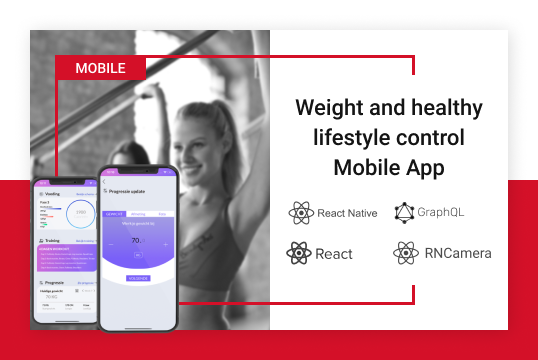
Healthcare lifestyle Mobile App example
Why you need a Mobile App Business Plan
As we have already found out, precise planning provides structure, guidance, and a strategic approach to your development journey, increasing the likelihood of success and helping you navigate the competitive app market. In addition, having a business plan for mobile application development is also beneficial because:
- It helps you make informed decisions about features, target audience, marketing strategies, and monetization models, ensuring you align your actions with your general business goals.
- It assists in resource planning, including budgeting, staffing, and timeline management, enabling you to allocate them effectively.
- It helps identify potential risks and challenges early on, allowing you to devise strategies to mitigate them and improve the overall success of your mobile app.
- It establishes criteria for evaluating the effectiveness of processes, allowing you to make adjustments and improvements as necessary.
- At last, a well-crafted business plan demonstrates your seriousness and commitment to investors, increasing the chances of securing funding for your app.
The list of reasons your business should start working on its mobile app with a business plan goes on and on.
Is it possible to develop mobile software without first drafting this document? Obviously yes. Will it be an organized process with clear outcomes? Obviously not. The choice, of course, is yours, but our clients have developed their plans, and now enjoy predictable results.
Business Plan for a Mobile App and other software: 3 difference
Although the business plan itself is a standardized document and is compiled according to a certain pattern, we still recommend considering those features directly related to building such a software product as a mobile application.
Suppose we exclude positions common to the development of any other software. In that case, we will find that mobile apps differ significantly in a unique set of functions, specifics of reaching the target audience, and various monetization strategies.
Of course, creating a high-quality and user-friendly mobile application requires appropriate skills and a team of competent developers. The article “IT Outstaffing company vs IT Recruitment agency” will tell you where to find the best programmers for your mobile project, but now let’s explore the differences deeper.
Feature set
Your business plan should consider certain mobile technology features and highlight their relevance to the target market. Focusing on the specificity of user experience, usability, scalability, and other unique benefits that give the app a competitive edge is important.
Mobile apps often leverage device-specific features such as GPS, camera, accelerometer, push notifications, and touch gestures. These features enable unique functionalities and interactions tailored to the mobile experience.
Mobile software must adapt to different screen sizes and orientations, ensuring a seamless usage across various mobile devices. Responsive design and optimized layouts are crucial aspects of the feature set for any mobile app.
Mobile apps have to be lightweight, fast, and responsive to deliver a smooth user experience. Optimization for battery consumption, network efficiency, and performance are critical considerations.
Mobile applications may offer offline functionality, allowing users to access certain features or content without an internet connection. It may be vital for apps involving content consumption, productivity tools, or work in areas with limited connectivity.
Mobile apps often integrate with other mobile applications or services to enhance functionality and user convenience. Integrations with third-party APIs, social media platforms, payment gateways, or other mobile apps can significantly improve their capabilities and user satisfaction.
Marketing approach
Your business strategy must include specific decisions in marketing a mobile app, app store optimization, in-app advertising, mobile advertising networks, user acquisition and retention tactics, app review management, and influencer attraction.
Mobile apps rely heavily on app stores (such as the Apple App Store or Google Play Store) for user discovery and downloads. You must plan App Store optimization activities to optimize various elements of the app store listing, including the app title, keywords, description, screenshots, and reviews, and improve visibility and increase organic downloads.
Mobile applications focus on acquiring and retaining users through various tactics such as referral programs, incentivized downloads, push notifications, email marketing, social media marketing, and content marketing. App developers often leverage analytics and user behavior data to optimize acquisition and retention strategies.
Mobile software significantly depends on user reviews and ratings, which can substantially impact app store rankings and user trust. Managing app reviews, responding to user feedback, and actively seeking positive reviews are essential components of the marketing approach.
Collaborating with influencers with a big mobile app-related audience can be an effective marketing choice. Influencers create inviting content, provide app reviews or tutorials, and promote the app to their followers, driving app downloads and user engagement.
Mobile apps often utilize in-app advertising as a leading marketing strategy. It involves displaying ads within the applications to generate revenue or promote other apps/products. Ad formats specifically designed for mobile, such as banner ads, interstitial ads, or rewarded video ads, are commonly used in mobile app marketing campaigns.
Another way is to use mobile advertising networks, which provide platforms for advertisers to reach a broad audience through mobile-specific ad formats and targeting options. These networks enable app developers to run aimed ad campaigns across various apps and mobile websites.
Monetization strategy
Finally, these apps have specific monetization strategies due to the unique characteristics of mobile devices and the more personalized user experience of their owners.
Mobile apps often apply in-app purchases, where users can buy virtual goods, premium features, or access additional content. This strategy allows app developers to offer a free app with the option to make in-app shopping to enhance the facilities or unlock advanced features.
The freemium model is also widely used when the app is offered for free with basic features or content, but additional features or premium content require a purchase or subscription. This model allows app developers to attract a large user base and convert a portion of them into paying customers.
Mobile software may implement a subscription-based model, where users pay a recurring fee (monthly or annually) to access the app or its premium features. This strategy is commonly used for apps that provide constant value or content, such as streaming services, news apps, or productivity tools.
Mobile applications can monetize through various forms of in-app advertising, including display ads, native ads, video ads, or rewarded ads. Advertisements are integrated into the app interface, and app developers earn revenue based on ad impressions or user interactions with the ads.
Mobile apps may generate revenue through sponsorships or partnerships with brands or businesses. It can include promoting products or services within the app, featuring sponsored content, or offering special discounts.
Some mobile apps collect user data (with user consent) and monetize it by anonymizing and aggregating it to provide insights or targeted advertising to third parties. This strategy involves ensuring strict privacy and data protection measures.
Mobile apps with unique features, functionalities, or technologies can explore licensing or white labeling options, where they sell or lease their app to other businesses or organizations to use under their brand name.
As you may see, the possibilities of mobile applications are quite diverse and flexible that your business plan mobile app development must take into account by default.

What differs Mobile App business plan
What does a Business Plan for a Mobile App look like
A business plan for a mobile app is a comprehensive document that determines the strategy, goals, and financial projections for building and launching a software system. It serves as a roadmap for the development team and stakeholders, providing a clear vision of the app’s purpose, marketing strategy, financial viability, and implementation plan. Sample mobile app business plan usually consists of the following key sections:
- The executive summary provides an overview of the mobile app concept, target market, competitive advantage, and financial projections.
- The company description describes the background of the company or startup, including its mission, vision, and core values.
- The market analysis presents a detailed investigation of the target audience, including customer demographics, trends, market size, and competition.
- The overview of the mobile app thoroughly describes its features, functionality, and unique selling points.
- The marketing and sales strategy outlines the distribution channels, advertising, and promotional activities.
- Development and design detail the technical aspects of the mobile app development, including the tech stack, platforms, and development timeline.
- Operations and management describe the organizational structure, key personnel, and management team responsible for developing and maintaining.
- Financial projections present financial forecasts, including revenue projections, cost estimates, and profitability analysis.
- Funding requirements specify the investments needed for developing and launching the mobile app and potential funding sources such as investors or loans.
- Risk analysis identifies potential challenges associated with developing and launching the mobile software and contingency plans to mitigate those risks.
- The implementation plan outlines the procedure for executing the development and launch of the mobile app, including milestones and timelines.
- The appendix may include additional supporting documents such as market research data, technical specifications, and legal considerations.
For the competent preparation of this document, you can use the mobile app business plan examples available on the Internet, the services of consultants with solid expertise in mobile software development, and also study the step-by-step instructions below.
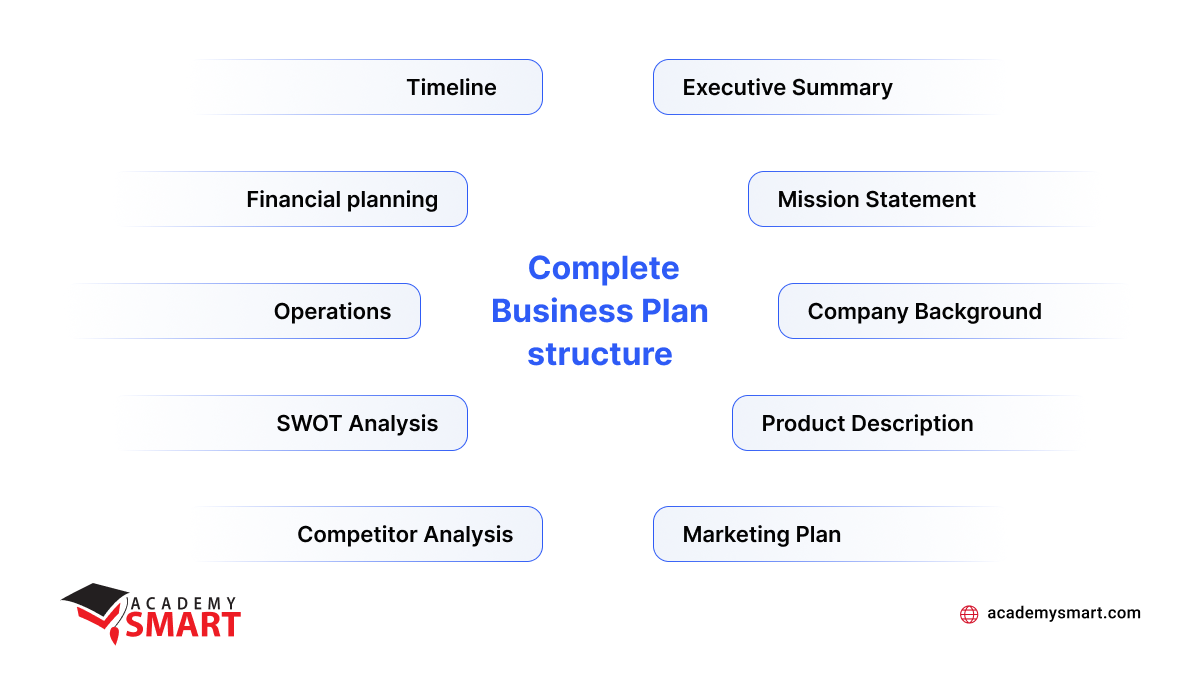
Mobile App business plan structure
How to write a Business Plan for a Mobile App
Creating a business plan for a mobile application development is a complex and responsible task requiring certain managerial experience, knowledge of market specificity, understanding of the processes of creating and promoting online software, and sensitive intuition.
Above, we have already considered the typical structure of that documentation, and now we’ll get acquainted with its content in detail. However, first, please accept one life hack from us that greatly simplifies the writing process: fill in the Executive Summary section last. If you consistently research, analyze and complete the remaining units, getting out the essential information for summary will no longer be difficult.
1. Present your company
How to write a business plan for mobile app development if this is your first time? The simplest way is to start by introducing your company or startup. Set the foundation for the rest of the plan in this section and include essential information about your company’s background, mission, vision, and values.
This part should clearly define who you are, what you aim to achieve, and the unique qualities that differentiate your company from competitors. It would help if this section correctly reflects the history of your previous business successes, closed deals, and profitable products. Also, it involves describing your company’s legal structure, location, and any notable milestones or achievements that showcase your company’s credibility and potential for success.
2. Describe your mobile app
The next step involves a detailed overview of your app’s features, functionalities, and target audience. This section should clearly articulate the purpose of your mobile app and highlight its unique value proposition. It aims to describe what your app does and how it will resonate with the intended users.
It should outline the key features and benefits your app offers users, explaining how it solves a specific problem or meets a particular need in the market. Here you should provide information on the platforms your app will be available (such as iOS, Android, or both) and any technical requirements or dependencies, such as technology stack, cloud solutions, and third-party services that have to be used. Additionally, it is crucial to provide for scalability, security, and performance optimization factors.
Another essential task is to support your app’s vision with market research results. It helps you demonstrate the market landscape knowledge, identify competitors, analyze user preferences and behaviors, and assess market trends and opportunities. This information shapes your software’s value proposition, positioning, and marketing strategy.
So, your business plan for mobile app development should provide data and insights you’ve gathered by conducting thorough market research and analysis to show how well your app fits your target niche and satisfies the goals stated above.
3. Justify your marketing strategy
At the next stage, you must explain your approach to promoting and distributing your mobile application to your target audience. The goal is demonstrating a well-thought-out marketing plan to effectively reach and engage your target users and drive app adoption and usage.
This section should provide a holistic overview of your marketing activities, highlighting how you will create awareness and generate user acquisition. You should outline your key channels and tactics, such as digital advertising, social media marketing, content marketing, app store optimization, influencer partnerships, or other strategies relevant to your market niche.
It’s crucial to align your marketing strategy with your app’s unique value proposition and audience needs, ensuring that your messaging and promotional efforts effectively communicate the benefits and value of your software. Additionally, you may include details on pricing strategies, partnerships with suitable stakeholders, and any other marketing initiatives you plan to undertake.
4. Determine the parameters and terms of development
In this step, you outline the technical aspects of developing your app and establish key parameters and terms to guide the development process. Determining them ensures the app-building process is well-defined and aligned with your common business objectives. It provides a roadmap for the technical implementation of your mobile app and helps you establish realistic expectations regarding the development timeline, costs, and deliverables.
You should establish the development team’s roles and responsibilities, including designers, developers, testers, and project managers. You have to evaluate the available human resources and the expertise of the internal team if you have one. Also, you should carefully weigh the competencies of contractor partners and, if necessary, include in the business plan the search and transition to another IT service provider. At last, this step also involves setting milestones, deadlines, and budgetary considerations related to releasing a mobile software product and its continued support.
5. Plan financial performance
This part of the business plan focuses on estimating the costs of developing, launching, and marketing the app and projecting the potential revenue and profitability. Here you analyze and forecast the financial aspects of your mobile app venture.
By planning them, you gain a deeper understanding of the economic viability of your mobile app business. It helps you determine the funding requirements, assess the profitability, and attract potential investors or lenders. Additionally, it serves as a benchmark to track the actual financial indicators against the projected goals and make informed decisions to optimize revenue and control costs.
To plan financial performance holistically, you have to:
- Determine the costs associated with app development, including salaries of the development team, design and development tools, software licenses, and any third-party services or APIs required.
- Estimate the ongoing operating expenses like hosting, server maintenance, customer support, and marketing expenses.
- Identify the potential revenue streams for your app, such as in-app purchases, subscriptions, advertisements, or partnerships. Analyze the market potential and competition to determine realistic revenue projections.
- Decide on the pricing model for your app, whether it will be a one-time purchase, freemium with in-app purchases, or a subscription-based model. Consider the perceived value of your app, user preferences, and market trends while setting the pricing.
- Choose a comprehensive sales and marketing strategy to promote your app and acquire users. Estimate the marketing budget required for user acquisition campaigns, digital advertising, app store optimization, and other promotional activities.
- Create financial projections, including cash flow statements, profit and loss statements, and balance sheets, for at least the first few years of your app’s operation. Consider different scenarios and sensitivity analyses to assess the financial feasibility and potential risks.
6. Set business growth criteria
Setting achievement standards establishes clear objectives and targets for your mobile app’s development and market success. These key performance indicators (KPIs) and growth metrics help you track the progress of your application performance, measure its effectiveness, and identify areas for improvement. They also serve as benchmarks for expanding your mobile app venture to drive further scaling and profitability.
To set the effective progress indicators, you should:
- Define the target number of app installations or registered users you aim to achieve within a specific timeframe. This metric indicates the growth of your user base and market reach.
- Establish revenue-related goals, such as the projected increase in monthly or annual revenue. That may include targets for total revenue, average revenue per user, or income from specific monetization channels.
- Determine the desired market share you want to capture in your target market. It can be measured by the percentage of app downloads or user engagement compared to your competitors.
- Set metrics to track user retention and engagement, such as the percentage of active users, user session duration, or repeat app usage. These metrics indicate the app’s ability to retain and engage users over time.
- Consider incorporating customer satisfaction metrics like user ratings, reviews, or Net Promoter Score. Aim for a target satisfaction level that reflects a positive user experience and indicates high app quality.
- If you plan to expand your app’s reach into new markets or geographic regions, define the KPIs for successful market entry, such as the number of new niches entered or the market penetration rate.
7. Write an Executive Summary
The Executive Summary is a concise and compelling business plan overview, highlighting the key points and capturing the reader’s attention. For this reason, it is best to start preparing it when the remaining sections of the document have been worked out in detail and conceptually formulated.
Remember, the Executive Summary is often the first section of your business plan that potential investors, stakeholders, or partners will read first. Therefore, it is crucial to make a strong impression straightaway and effectively communicate your mobile app’s unique value and potential. This introduction should be concise, engaging, and persuasive, capturing the reader’s interest and providing a comprehensive overview of your mobile app project. You have to write it in a way to encourage the reader to explore the complete business plan for more detailed information.
Here are a few tips on how to write a business plan for a mobile app with an inspiring Executive Summary:
- Begin with a brief entrance to your mobile app project, including its name, purpose, and target audience. Clearly state the problem your app solves and the value it offers to users.
- Provide an overview of the market opportunity, including market size, growth potential, and relevant industry trends or insights. Highlight the demand for your mobile app and how it addresses a specific need or gap in the market.
- Clearly define your mobile app’s unique selling proposition (USP) or competitive advantage. Explain what sets your app apart from competitors and why users should choose your app over others.
- Describe your app’s revenue model and monetization strategy. Explain how you plan to generate revenue through in-app purchases, subscriptions, advertisements, or other means. Include any projected financial figures or growth forecasts.
- Briefly outline your marketing strategy and how to attract and acquire users. Highlight any marketing channels, partnerships, or promotional activities to help you effectively reach your target audience.
- Summarize your team’s expertise and relevant experience, emphasizing key roles and their contributions to the mobile app’s success. Mention any strategic partnerships, advisors, or external resources that support your app’s development and growth.
- Include a summary of the financial projections, such as revenue forecasts, projected expenses, and expected profitability. Highlight key economic indicators and milestones.
- If you are seeking funding or investment, clearly state the amount required, its purpose, and how the funds will be utilized to support the app’s development, marketing, and growth.
Business Plan for Mobile App: how Academy SMART can help you
Academy Smart is an experienced team of mobile application developers for large enterprises in various sectors of the economy. With the help of our consultants – technical experts in the industry – you can get a professional assessment of your corporate mobile app development plans. And thus, it will be easier for you to set specific decisions regarding the human resources and information technology needed for this challenge in your business plan.
Use the services of our company for developing turnkey mobile software or forming a project-oriented dedicated development team to complete the contractor’s tasks. Moreover, skilled outstaffing programmers from the Academy Smart agency will significantly help your in-house development team.
We have developed over 100 high-quality mobile solutions for companies in 14 countries. Contact us, and we’ll be glad to discuss yours.
Mobile App Business Plan: Frequently Asked Questions
How long does it take to write a Business Plan for an App?
The time can vary depending on several factors, such as the app’s complexity, the level of detail required in the plan, and the experience of the person or team writing it. Generally, completing a comprehensive business plan can take anywhere from a few weeks to a few months.
What is an executive summary of a Mobile App Business Plan?
The executive summary of a mobile app business plan is a concise overview of its key elements. It should capture the reader’s attention and provide a clear understanding of the app’s value proposition and its profit potential.
Book a free consultation

Reach out to start talking today!

